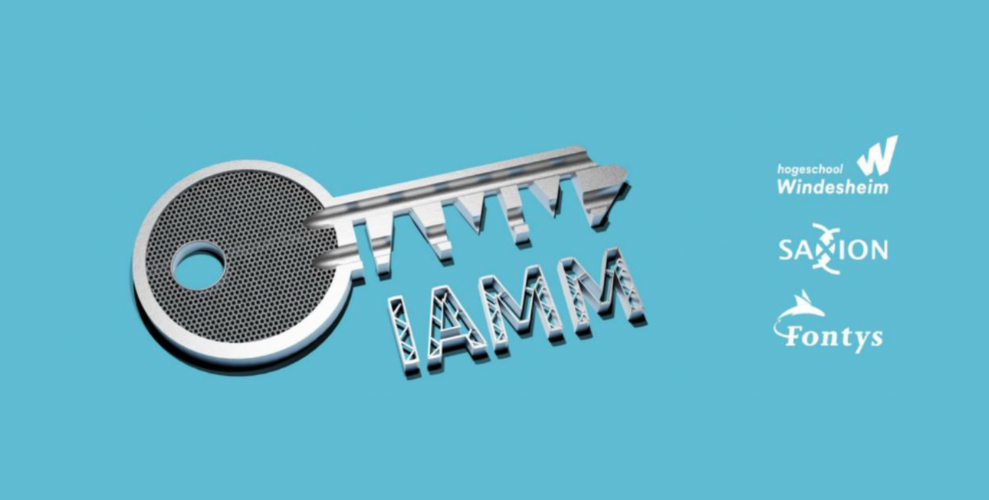3D metal printing opens up opportunities for new economic activities worldwide. The key technology offers diverse techniques, which are increasingly being used and are a driver of innovation in numerous sectors. In this area, however, the Netherlands can still make considerable strides. After all, the possibilities offered by 3D metal printing are not yet always known in practice. Even companies that have invested in it before are still struggling with practical questions in many cases. To help get the technology and its implementation up and running, the SPRONG group Industrial Additive Manufacturing Metal (IAMM) was therefore set up. Windesheim’s Professorship of Plastics Technology, based at Perron038, is part of this group.
SPRONG application honoured by Regieorgaan SIA
The Plastics Technology lectureship of Windesheim University of Applied Sciences, together with the Saxion and Fontys universities of applied sciences, is therefore joining forces in the SPRONG group IAMM. We are proud to announce that our SPRONG application has been honoured by the National Organisation for Applied Research SIA. Thanks to the funding from SIA and co-financing of 50% from the business community and hbo, we will be able to work for the next 4 years on setting up a knowledge infrastructure for the whole of the Netherlands – with a possible extension for another 4 years. This infrastructure will open the doors for companies towards more research and education, with the ultimate goal of unlocking this key technology for the Netherlands. The Professorship of Plastics Technology has a 3D metal printer which is used at Perron038.
3D metal printing and the opportunities it offers
3D metal printing is a key technology because it offers new technological solutions with a wide range of business side effects. For example, one of the advantages of 3D metal printing is the diversity of design possibilities. This allows you to print unique shapes that you would never, ever have been able to produce with conventional metalworking techniques. 3D metal printing, for example, leads to new and lighter designs in the aviation industry, allowing it to reduce its fuel consumption.
Another example of the benefits 3D metal printing offers is that it can be used to shorten the supply chain, allowing companies to deliver products to their customers faster. Where previously companies had to import spare parts from abroad and have them stored somewhere, they can now easily be printed on site.
Why not yet in The Netherlands?
Countries like Germany, Belgium and France are ahead of the Netherlands when you look at the application of 3D metal printing. In the Netherlands, there is currently still a lack of expertise and know-how. And it is precisely the acquisition of state-of-the-art knowledge, expertise and know-how that is necessary, as 3D metal printing techniques continue to develop at a rapid pace. This is exactly what companies need in the Netherlands. Together with the IAMM Group, we hope to make a difference there.
IAMM
IAMM focuses on practice-based research into innovative developments and innovative applications of 3D metal printing. In recent years, the colleges involved have invested in facilities for and research into 3D metal printing, together with a large number of companies and institutions. By collaborating intensively, a decisive research group has emerged with a large geographical reach in the Netherlands, various facilities and specialisations. Within the group, we will collaborate with regional field labs and several Centres of Expertise, namely: HTSM Fontys, Green PAC and TechForFuture. This network will be further strengthened by our collaboration with Flam3D, the network organisation for 3D printing in the Benelux.
Objective
IAMM’s objective is to grow into a powerful and practice-oriented research group over the next eight years. A research group that develops new knowledge about the techniques and applications of 3D metal printing. This knowledge flows directly back to the field and contributes to up-to-date education on this key technology. In concrete terms, this means:
- Broadening the current research profile to new application areas for 3D metal printing
- Strengthen the competences of existing and new employees by using the complementary knowledge and facilities of the universities of applied sciences and the organisations involved
- Broaden the network for demand articulation and knowledge sharing with the field
- Develop up-to-date education at undergraduate and graduate level on the latest techniques and applications
- Developing a quality system focused on professional work
- Setting up a national infrastructure for research and education for companies, with which we hope to unlock this key technology for the Netherlands
Thanks to the SPRONG grant by SIA and co-funding from industry and universities of applied sciences, we want to jointly put 3D metal printing on the map within the manufacturing industry in the Netherlands.
More information?
Questions about this project, you can send to info@3diamm.eu or get in touch with:
– Margie Topp, Lector Additive Manufacturing – m.topp@windesheim.nl
– Geert Heideman, Associate Lector Additive Manufacturing – g.heideman@windesheim.nl


